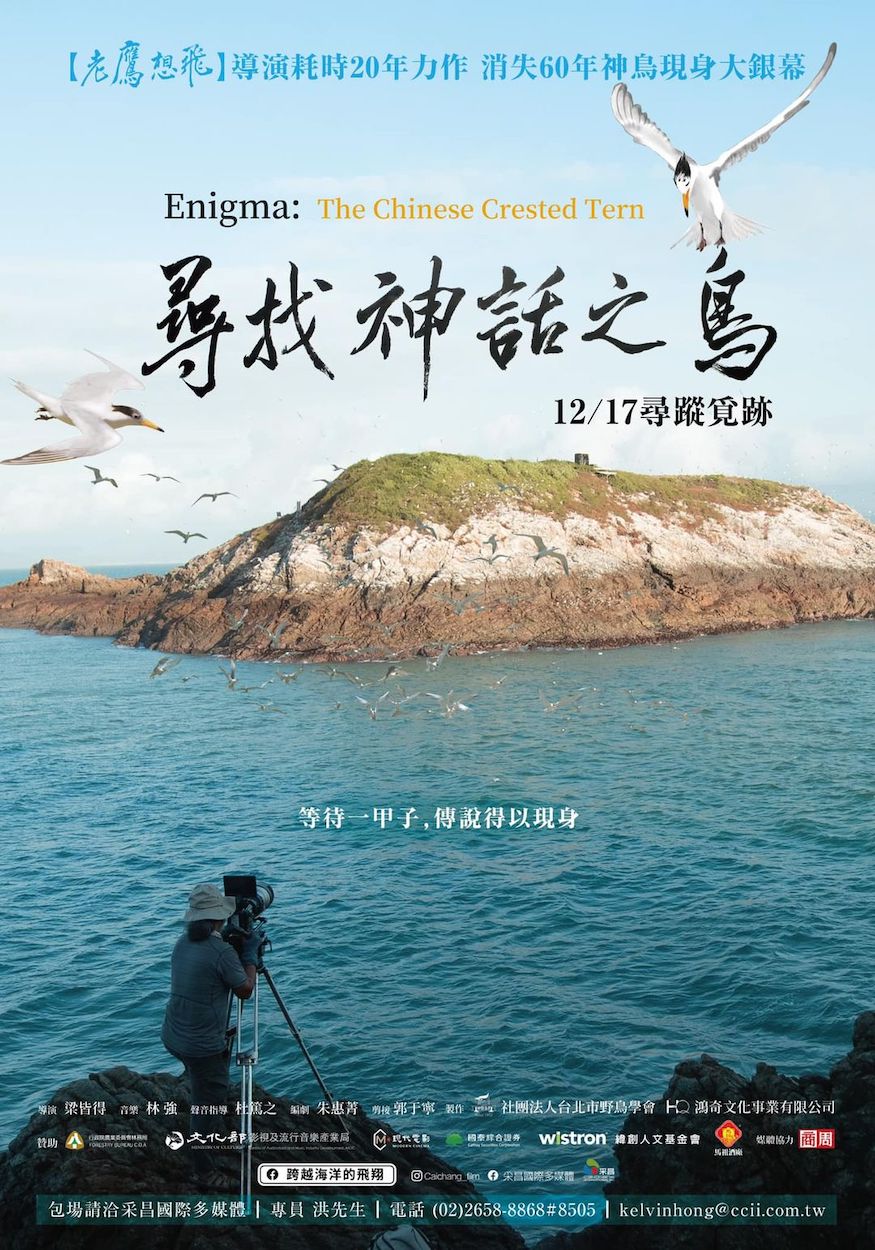by Brian Hioe
語言:
English
Photo Credit: Film Poster
ENIGMA: THE CHINESE CRESTED TERN (尋找神話之鳥), directed by Taiwanese environmentalist filmmaker Liang Chieh-Te (梁皆得), is a masterful depiction of the eponymous endangered species. The film goes a long way in showing not only the beauty of the creature and providing many revealing looks into its life, but also the Herculean efforts of an international team of conservationists and researchers to protect a species that may have less than one hundred remaining individuals.
Liang puts a personal cast in the film, documenting twenty years spent hunting for the elusive bird between Taiwan, China, Malaysia, the Philippines, and other places. Prior to Liang noticing a lone Chinese crested tern in footage in Mazu captured for another documentary on the much more common greater crested tern, the Chinese crested tern had not been seen for over sixty years and there were only four surviving specimens. This led to questions about whether the bird existed at all, or whether it was a myth–so the bird was subsequently termed the “bird of myth” in Taiwanese media. In the time that Liang spends pursuing the bird, his daughter grows up, eventually assisting him in his efforts.
A prevalent feature of contemporary Taiwanese documentary is a strong personal angle, in which documentaries about environmental issues or larger macro-historical events have a personal story injected into the narrative. But where Liang’s story is concerned, this primarily serves as a frame for the film’s narrative, since Liang was the first to document surviving Chinese crested terns and he played a role in efforts to understand more about the bird’s lifestyle and save it from extinction.
Namely, surviving Chinese crested terns usually live and nest among flocks of greater crested terns, with both birds having similar life cycles and being remarkably similar to each other at first glance, except for that the Chinese crested tern has a different bill marking and is colored white rather than grey. Searching for the Chinese crested tern, then, proves an endless process of searching for a needle in a haystack between multiple countries.
Apart from the inherent difficulty in finding single-digit numbers of Chinese crested terns among large flocks of thousands of greater crested terns, Liang’s skill as a filmmaker shows quite clearly through the skillful depiction of the Chinese crested tern. Liang is able to convey how the Chinese crested tern engages in courtship, raises its young to walk and fly, and both socializes and squabbles with other birds.

Photo credit: Film Poster
Liang vests the Chinese crested tern with a great degree of personality, bringing out not only the beauty of the bird in flight or while fishing, but how its actions are sometimes quite cute. What is all the more remarkable is that Liang conveys a sense of the Chinese crested tern’s lifestyle even as he and other researchers learn more about it in real-time, learning where the Chinese crested tern nests for the winter, or how its chicks differ in coloration from the greater crested tern.
Efforts to document, study, and save the Chinese crested tern are also illuminating, showing how environmentalists build nests with decoy birds to attract the Chinese crested tern to suitable habitats, or laboriously spend months at a time in hunt of clues for where the bird may nest. This is very clearly an international endeavor, with Liang and other Taiwanese cooperating with a number of Chinese researchers and spending great periods of time on the hunt for the bird far from civilization.
The Chinese crested tern’s survival is threatened by development and overfishing, which threatens the habitats that the bird occupies. Addressing the issue requires international solutions, seeing as fishing vessels that illegally cross borders to fish near protected areas threaten the Chinese crested tern.
As with other documentaries in the past decade about endangered species, such as The Lost Sea (刪海經), perhaps there is something of a metaphor for Taiwan to be found in the Chinese crested tern. The Chinese crested tern is overshadowed by the much larger numbers of greater crested terns and hard to distinguish from among them, perhaps not unlike how Taiwan is overshadowed by its larger neighbor of China.
Yet the work ultimately points toward the utopianism of peaceful international collaboration across borders to save the Chinese crested tern by Taiwanese, Chinese, and others as a worthy and necessary endeavor. It is no doubt that this is what Liang hopes to encourage in the film, with glimpses into the extensive efforts across borders to save the Chinese crested tern, and the suggestion that this would be the most desirable outcome for all concerned.


